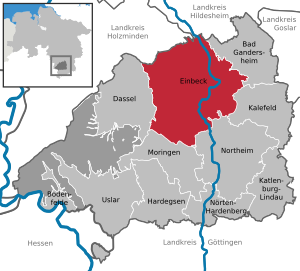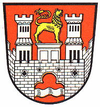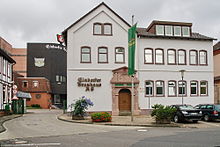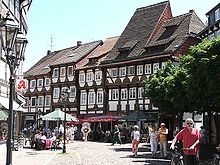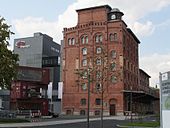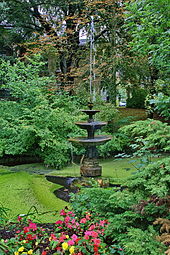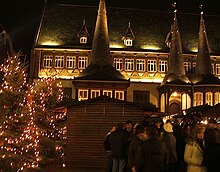Einbeck
| coat of arms | Germany map | |
|---|---|---|

|
Coordinates: 51 ° 49 ' N , 9 ° 52' E |
|
| Basic data | ||
| State : | Lower Saxony | |
| County : | Northeim | |
| Height : | 112 m above sea level NHN | |
| Area : | 231.31 km 2 | |
| Residents: | 30,689 (Dec. 31, 2019) | |
| Population density : | 133 inhabitants per km 2 | |
| Postal code : | 37574 | |
| Primaries : | 05553, 05554, 05561, 05562, 05563, 05565, 05582 | |
| License plate : | NOM, EIN, GAN | |
| Community key : | 03 1 55 013 | |
| LOCODE : | DE EIB | |
| City structure: | 46 districts | |
City administration address : |
Teichenweg 1 37574 Einbeck |
|
| Website : | ||
| Mayoress : | Sabine Michalek ( CDU ) | |
| Location of the city of Einbeck in the Northeim district | ||
Einbeck is a former Hanseatic city , a medium-sized center and an independent municipality in the Northeim district in southern Lower Saxony and is recognized as a Lower Saxony excursion destination .
In terms of area, Einbeck is the largest city in southern Lower Saxony and the largest city in the district in terms of population. The cityscape in the center is characterized by more than 150 late medieval half-timbered houses. Einbeck is known as the beer town because of its centuries-old brewing tradition. The name bock beer is derived from the name of the city.
geography
Geographical location
Einbeck is located in the Einbeck-Markoldendorfer basin immediately south of the Hube ridge (Fuchshöhlenberg 346.2 m above sea level ). The closest major cities are Göttingen in the south (around 30 km) and Hildesheim in the north (around 35 km). The Harz begins around 20 kilometers east of the city limits, the Solling around 15 km west and the smaller Ahlsburg ridge around five kilometers south-west.
The name Einbeck refers to the stream flowing through the place (Middle Low German = Beeke ), the Krumme Wasser , a northern tributary of the Ilme . The Ilme runs through the southern areas of the city center, then passes the Altendorfer Berg and flows a few kilometers further east into the Leine coming from the south .
climate
|
Monthly average temperatures and precipitation for Einbeck (1961–1990)
Source:
|
||||||||||||||||||||||||||||||||||||||||||||||||||||||||||||||||||||||||||||||||||||||||||
Neighboring communities
Einbeck borders clockwise (starting in the north) on the community Freden (Leine) (district Hildesheim), the city Bad Gandersheim , the community Kalefeld , the cities Northeim , Moringen and Dassel (all district Northeim) as well as the community Eimen , the community-free area Wenzen and the spots Delligsen (all in the district of Holzminden).
Districts
Of the roughly 32,000 inhabitants of the unusually large city, around 15,000 live in the core city, the rest are spread across the 46 districts of Einbeck:
history

middle Ages
In the early Middle Ages, there were already several villages on the Ilme in the middle of the Leinetal when Einbeck was founded. On January 1, 1158, Friedrich Barbarossa had a document … in loco qui Anbike vocatur… recorded , which referred to a transfer of goods in the 11th century. Count Udo von Katlenburg owned an estate here on the Krummen water floodplain, where his grandson later founded the St. Alexandri monastery , which became an important place of pilgrimage. On the opposite side of the brook, the market settlement with the market church was built at the end of the 12th century in a convenient location. The Bachaue between the market and the monastery was filled in and settled. The wall with a moat around the market settlement and the monastery around 1250 was the beginning of the Einbeck city fortifications with the city wall first mentioned in 1264. In 1252 Einbeck had city rights , a city council was mentioned, in 1279 Einbeck was granted extended city rights by the sovereign Heinrich Mirabilis . In the following years Einbeck experienced a topographical expansion, so in 1264 a city wall is mentioned which enclosed the market church of St. Jacobi and the collegiate church of St. Alexandri. The Neuemarkt, which is documented in 1389, and the Neustadt with its parish church of St. Mariae, which is called in 1318 , joined the two churches, located in the old town with the Old Town Market .
The city gained in importance under the rule of the Dukes of Grubenhagen . Many citizens of the surrounding old, therefore submerged, villages such as Oldendorf or Tiedexen moved there. The first exports of Einbecker beer are documented in 1351. The beer was brewed in the town houses with brewing rights - still recognizable today by the large gates for the brewing pan - the organization and marketing was carried out jointly by the city council. In 1368 Einbeck joined the Hanseatic League, which considerably expanded the sales area for Einbeck beer: it stretched from Antwerp to Riga and from Stockholm to Munich. In the 14th and 15th centuries, an Augustinian choir woman - an Augustinian hermit - and a Clarisse monastery were built, a mill canal was built and a landwehr was built . At that time Einbeck was one of the larger cities in Northern Germany. It was a golden age for Einbeck.

After 1200 and around 1400 two medieval leprosoria can be traced in Einbeck, the former was in front of the Altendorfer Tor. The leprosoria were later converted into an old people's home and poor house. They were consecrated to St. Bartholomew and St. George. The location of the later infirmary is unclear.
Modern times
In 1540, the town was almost completely destroyed in the Einbeck fire. The previously generated wealth allowed a rapid reconstruction. Joining the Schmalkaldic League was costly. In 1549 580 houses burned down in the southern half of the city. In 1580, "the town council of Eimbeck" signed the Lutheran formula of concord from 1577. In 1597 the plague claimed numerous victims, as well as in 1626. In the Thirty Years War the town was occupied in 1632 and 1641, hundreds of houses were destroyed, in the Seven Years War the fortifications were blown up. While the neighboring Rotenkirchen developed into the official seat, the sovereigns were able to restrict the political independence of the weakened city. Einbeck took on a garrison of infantry units, which later formed Hanoverian units. As a result, the economic development improved again. 1807-1813 Einbeck was the seat of the sub-prefecture of the Einbeck district . The quarter around the Neustädter Church burned down in 1826, and the Einbeck District Court building was built next to it. A Prussian barracks was built in 1869 (today the New Town Hall with the seat of the city administration). In 1879 Einbeck was connected to the railway network with the Ilmebahn . In 1885 Einbeck became the administrative seat of the newly founded district of Einbeck. From 1890 the bicycle business August Stukenbroks the largest mail order company in Germany developed, but declined in 1931 by the global economic crisis in bankruptcy . In 1896 the garrison regiment withdrew from the city. In 1899 the gendarmerie school was founded. A technical university was founded in the old barracks in 1871 and existed until 1907.
During the November pogroms in 1938 , the synagogue on Bismarckstrasse was burned down. The former synagogue on Baustraße was preserved as it served as a private residence. The future city director Keim handed the city over to the US Army in 1945 without orders from the military substitute inspector of military district XI, so that the city remained largely undamaged.
In 1946, Einbeck's population doubled as a result of displaced persons from the former eastern German territories, especially from Silesia , who found a new home in the town and district of Einbeck. This resulted in an urban expansion, with the residential buildings being erected mainly in an easterly direction and then commercial buildings mainly in a southerly direction. Several important companies settled here, including KWS. In 1971 four villages were incorporated. The Einbeck district was dissolved in 1974 as well as the incorporation of a further 27 places from the former Einbeck, Gandersheim and Northeim districts. Einbeck is a medium-sized center and an independent city. In 2005 a major fire in the old town destroyed a historic half-timbered house and damaged five others. Seven years later, two more of the listed buildings were destroyed. In 2013 part of the western industrial area was replaced by a shopping park.
Incorporations
On February 1, 1971, the communities Holtensen, Hullersen, Immensen and Odagsen were incorporated. On March 1, 1974 came Andershausen, Avendshausen, Bartshausen, Brunsen, Buensen, Dassensen, Dörrigsen, Drüber, Edemissen, Hallensen, Holtershausen, Iber, Kohnsen, Kuventhal, Naensen, Negenborn, Rengershausen, Rotenkirchen, Salzderhelden (Flecken), Strodthagen, Stroit , Sülbeck, Vardeilsen, Vogelbeck, Voldagsen, Volksen and Wenzen.
Also on March 1, 1974, the communities of Ahlshausen-Sievershausen, Bentierode, Beulshausen, Billerbeck, Bruchhof, Erzhausen, Garlebsen, Greene (Flecken), Haieshausen, Ippensen, Olxheim, Opperhausen, Orxhausen and Rittierode were incorporated into the community of Kreiensen. Today they belong to the city of Einbeck.
On October 19, 2011, the city council decided to merge with the neighboring community of Kreiensen on January 1, 2013. On January 1, 2013, the law on the unification of the community of Kreiensen and the city of Einbeck came into force. This means that Einbeck is the legal successor to the municipality of Kreiensen and has grown considerably again after the local government reform of 1974.
Surname
Old names of the place are 1103-1106 Enbiche , 1105 Enbike , 1134 Eguuardo preposito de Enbeka , 1139 Einsteche and 1146-1154 prepositus de Embeke . The basic word of the place name "-beke" is Low German and stands for Bach. The qualifier “En-” probably goes back to the old Indo-European roots “ei-”, “oi-”, “i-”, that is, “go” with n-derivative in the river name, as it occurs in several river names known today . The place name can also be found as a legend on a coin from this city, which was a mint between 1498 and 1717.
Population development
| year | Residents | of which (if known) |
|---|---|---|
| End of the 14th century | 3000-4000 | |
| Early 16th century | 6000-7000 | |
| 1890 | 7,676 | 332 Catholics, 151 Jews |
| 1910 | 9.431 | |
| 1925 | 9,683 | |
| 1933 | 10,089 | 9053 Evangelicals, 699 Catholics, 8 other Christians, 58 Jews |
| 1939 | 10,046 | 8813 Evangelicals, 759 Catholics, 12 other Christians, 9 Jews |
| 1950 | 17,759 | |
| 1961 | * 18.602 | |
| 1971 | * 19,095 | |
| 1977 | 29,432 | |
| 1980 | 28,900 | |
| 1987 | * 29,378 | |
| 1990 | 29,905 | |
| 2000 | 29,355 | |
| 2010 | 27.164 | |
| 2017 | 30,925 |
(Results from a census are marked with a *)
politics

City council
On September 11, 2016, the city council and the local councils were newly elected:
| Political party | Seats 2016 |
Seats 2013 |
Seats 2011 |
Seats 2006 |
|---|---|---|---|---|
| SPD | 19th | 19th | 14th | 16 |
| CDU | 13 | 14th | 9 | 14th |
| UWG-GfE | 4th | 4th | 8th | - |
| BL-UWG-Kreiensen | 2 | 3 | - | - |
| GREEN | 2 | 2 | 2 | 1 |
| FDP | 2 | 2 | 2 | 4th |
| AfD | 2 | - | - | - |
| LEFT | - | - | 1 | 1 |
City Directors
- 1948–1981 Heinrich Keim
- 1981–1992 Georg Lampe
- 1992–1997 Bernd Röll
Mayor from 1998
The mayor's post has been full-time since 1998.
- since January 25, 2013: Sabine Michalek (CDU)
- November 1, 2006 to January 24, 2013: Ulrich Minkner (SPD)
- January 1, 1998 to October 31, 2006: Martin Wehner (SPD)
Mayor until 1997
From 1946 to 1997 the mayor's post was honorary.
- 1991 to 1997: Martin Wehner (SPD)
- 1981 to 1991: Wilhelm Dörge (CDU)
- 1972 to 1981: Herbert Voges (SPD)
- 1968 to 1972: Wilhelm Dörge (CDU)
- 1964 to 1968: Auguste Jünemann (SPD)
- 1961 to 1964: Wilhelm Dörge (CDU)
- 1959 to 1961: Auguste Jünemann (SPD)
- 1957 to 1959: Ernst Karnebogen
- 1954 to 1957: Christian Eggers
- 1948 to 1954: Wilhelm Messerschmidt (SPD)
- 1946 to 1948: Otto Ammermann (appointed by the British military administration)
- April to May 1945: Heinrich Keim (deployed by the US Army)
- until March 1945: Karl Schrader
- 1933 to 1945: Otto Hildebrecht (NSDAP)
- 1920 to 1933: Hans Oehlmann
- 1918 to 1920: Victor Ibach
- 1907 to 1918: Gerhard W. Nedden
- 1893 to 1907: Paul Troje
- 1880 to 1893: Franz Grimsehl
- 1868 to 1879: Julius Ludowieg
- 1852 to 1868: Wilhelm Claus von Uslar
- Johann Otto Ernst (born approx. 1678)
- Johann Friedrich Crauel (1629–1703)
- Johann Heinrich Wilhelm Berkelmann (1633-after 1697)
- Christian Wilhelm Johann Engelbrecht (1612-1675)
- Heinrich Peträus (1579-1640)
- since 1623: Jobst Raven (1570-1633)
- since 1568: (14 times) Johann Christian Schwarzkopf (1532-1595)
- Hans Diek (1562-1618)
- Jobst Diek (1530-1598)
- 1542: Hans Rodemeyer (approx. 1490-after 1542)
- Georg Pabst (approx. 1490-after 1565)
- Heinrich Henke (born approx. 1490)
- 1497: Otto von Uslar
- 1484/86: Dietrich II. Raven (died 1495)
- 1440/49: Dietrich Raven (d. 1449)
- 1422: Gise von Uslar
- 1410: Milies from one (died 1436)
- 1405: Hans von der Brüggen (Thorbrügge)
- until 1387: Cord Thor Bruges (approx. 1340-1387)
- 1355: Hans Raven (c. 1300-before 1381)
Town twinning
-
 Thiais (Val-de-Marne Department), France since 1962; the Oberkreisdirektor of the district Einbeck , Walter Schaefer , became an honorary citizen of Thiais because of his services to the Franco-German relations
Thiais (Val-de-Marne Department), France since 1962; the Oberkreisdirektor of the district Einbeck , Walter Schaefer , became an honorary citizen of Thiais because of his services to the Franco-German relations -
 Artern , Germany since 1990
Artern , Germany since 1990 -
 Paczków (German Patschkau ), Poland since 1992
Paczków (German Patschkau ), Poland since 1992 -
 Keene, New Hampshire , United States since 2002
Keene, New Hampshire , United States since 2002
coat of arms
| Blazon : “In red a silver castle with two crenellated towers on the battlement wall , between them a golden lion ,turned to the left ,standing on a pedestal; a silver wave bar in the open cloverleaf arch . " | |
| Justification of the coat of arms: The lion comes from the Guelphs , the waves go back to the Krumme Wasser , while the towers and walls emphasize Einbeck's character as a city. In previous seals since 1558, the lion was turned to the right. The water passage has been considered a gate since the 17th century, and a crown was added later. The earlier coat of arms contained a helmet with golden-red covers and a crowned E as the initial of the city's name. |
flag
The colors of the city flag are yellow and red.
Economy and Infrastructure
traffic
bus and train
About five kilometers from the city center, in spots Salzderhelden , located on the main route Hanover - Göttingen of Einbeck-Salzderhelden station . The Einbeck Mitte station, which is close to the city center , was not regularly served by passenger trains between 1984 and 2018, but only occasionally with special trains and was used for freight transport. The route to Dassel existed until 2002 and was then gradually dismantled to Juliusmühle . In the same year, the Einbeck-Salzderhelden - Einbeck Mitte line was transferred from DB to Ilmebahn GmbH. With the timetable change in December 2018, the resettlement was made of regional rail transport from Einbeck-center to Einbeck-Salzderhelden or Göttingen.
The most important train station in the city is the Kreiensen train station , where the Hanover - Göttingen , Braunschweig - Seesen - Kreiensen and Altenbeken - Kreiensen lines meet; the former station in Naensen on the latter route is no longer served.
The connection of the surrounding places to the city as well as the inner-city traffic in Einbeck are carried out with buses. The most important operators are Ilmebahn GmbH and RBB (Regionalbus Braunschweig GmbH). All bus lines in the Einbeck area belong to the Verkehrsverbund Süd-Niedersachsen (VSN).
Street
Einbeck is located on federal highway 3 , which connects the city with the state capital Hanover and the A 7 . The next junction of the A 7 is 13 km from the town center.
media
The Einbeck morning post appears in Einbeck with a local section for the cities of Einbeck and Dassel and the villages in the former district of Einbeck. Einbeck is also the seat of the advertising paper Die Eule , which appears free of charge in the region around Einbeck on Wednesdays and Saturdays.
Established businesses
Einbeck is also known for the Einbeck beer . Brewing has been going on in Einbeck since 1378. Today, the Einbeck Brewery AG symbolizes the over 600-year tradition of Einbeck beer brewers far beyond the region.
The Einbecker Blaudruck , a family business founded in 1638, is the oldest craft business in Europe that uses the traditional blue printing process to color textiles .
The KWS Saat SE & Co. KGaA (formerly Small Saatzucht ) bred for 150 years seeds for agricultural crops and is now with over 40 subsidiaries worldwide among the leading companies in plant breeding. The company employs around 1,500 people in the city.
The internationally active company Kurt König has been represented as a full-range supplier for construction equipment and construction machinery with its headquarters in Einbeck for 75 years .
With Kayser Automotive Systems and Dura Automotive Systems, two companies in the automotive supply industry as well as the chain manufacturer Arnold and Stolzenberg (part of the Renold Group ) and E. Oppermann Mechanische Gurt- und Bandweberei are based in Einbeck . The castle Müller GmbH , a subsidiary of Krauss-Maffei Group, is currently building a new plant for plastic machines, to be based in the second quarter 2020th
Another economic factor is tourism.
Educational institutions
Elementary schools
|
|
Further training
- Integrated whole school (IGS)
- Löns secondary school
- Goetheschule grammar school with full-time course
- Secondary and secondary school Kreiensen in Greene
professional school
- Einbeck vocational schools
- Nursing school
- Gendarmerie School (from 1899, renamed Landjägerschule in 1920, dissolved in 1929)
Sports
- RSV Einbeck
- SVG Einbeck
- ESV Einbeck
Culture and sights
The historic city center of Einbeck offers an almost completely preserved image of a late medieval half-timbered town . The Deutsche Fachwerkstrasse , established in 1990 , consequently also leads through Einbeck.
After a devastating city fire in Einbeck in 1540, the city was rebuilt in the following years in a uniform architectural style, whereby the location of the buildings above the vaulted cellars a few hundred years older was retained. The north side of Tiedexer Straße is considered the most beautiful ensemble . Here, in particular, the high gate entrances through which the brewery cars could pass have been preserved. More than half of all buildings had the right to brew .
Squares and half-timbered buildings
- The market square , the nucleus of the city, with the
- The old town hall from the 16th century with its three pointed towers is Einbeck's landmark.
- Brodhaus from 1552 is the seat of the Einbeck bakers' guild. The previous building at this location is said to have been mentioned as early as 1333.
- Ratsapotheke , a half-timbered building from 1590.
- The Eickesche Haus with its rich figural Renaissance half-timbered carving is classified as a “monument of special national and cultural importance”.
- The Tiedexer street , a closed road train with protected, timbered houses from the mid-16th century
- The New Town Hall was built in 1868 as a Prussian barracks, found a new use from 1907 as August Stukenbrok's mail order house and has served as the administrative center of the city of Einbeck since 1996.
- The Old Synagogue Einbeck to commemorate Jewish life in Einbeck
Churches
- Marktkirche Sankt Jacobi ( Evangelical Lutheran ), characterizes the Einbeck market square with its 65 meter high, leaning tower and has a Romanesque baptismal font, the oldest part of the city
- Münsterkirche Sankt Alexandri (Evangelical Lutheran), one of the largest Gothic hall churches in Northern Germany
- The church of St. Marien is also called Neustädter Kirche and is from the ev.-luth. Church district Leine-Solling and used by the Marie youth church . The building was inaugurated in 1968 and equipped with a new type of light installation in 2013. The previous building was the Neustädter Kirche Sankt Marien , which was restored from 1840–1846 by the Hanoverian city architect August Heinrich Andreae and demolished in 1963.
- Catholic Parish Church of St. Joseph (consecrated in 1895)
- Chapel of St. Spiritus , medieval building, used today by the regional community of the Greek Orthodox metropolis
- Church of the Evangelical Free Church Community ( Baptists ) in Baustraße 17
- The New Apostolic Church , built in 1986, was closed in 2014.
theatre
- Wilhelm-Bendow-Theater , operated by the cultural ring Einbeck
Museums
- PS-Speicher : A permanent exhibition on the history of mobility was created in the former granary in Einbeck. The museum opened in July 2014.
- Art house
- Stadtmuseum Einbeck , Auf dem Steinwege 11/13, with the newly designed “RadHaus” (bicycle museum) and beer museum
Parks
- The Stiftsgarten is north of the old town. It used to be a garden that was used by the Alexandri Monastery. The Garden of Generations is also located in this park . The Stukenbrokvilla, in which the Mendelssohn Music School is located today, is located in the eastern area of the Stiftsgarten.
- The Stukenbrokpark is located northeast of the old town between the city library and the bus station.
- The historical ramparts are best preserved west of the old town with the city wall at the baker's wall, the crows' ditch and the mill wall with a pond
- The officer's garden is in the south of the old town by the Diekturm.
Natural monuments
- Oak on the rattle tower with a chest height circumference of 8.70 m (2014).
Monuments
- The Stukenbrok monument commemorates mail order company August Stukenbrok. It was created by Otto Almstadt . It is located in the eastern area of the monastery garden, which was part of his property at times, opposite the fountain of the small park pond.
- Memorial in the fountain on the market square, for Till Eulenspiegel , who lived temporarily in Einbeck
- War memorial for the Franco-German War designed by Conrad Wilhelm Hase
- On the occasion of a campaign against the high unemployment rate in September 1998, citizens of Einbeck had the stumbling block built in the old town next to the market church . An information board embedded in the ground in front of the stone reports that it should remain there until unemployment is halved . The number of people without work in the city of Einbeck was 2341 at the time of the installation. The stone was removed in October 2007.
- The technical monuments include the gasometer , the Stroiter mill , the salt works Salzderhelden and the salt works Sülbeck .
Other buildings in districts
- The station building in the Einbeck district of Kreiensen is worth seeing . It was built in the Wilhelmine style in 1886–1889 and is still evidence of Kreiensen's past importance as a railway junction. The Kreiensener Heimatverein dedicates exhibitions in the community center and in the station building itself to rail and post operations, most recently in September 2016 on the 150th birthday of the reception building.
Einbeck in the film
In 1958, the black and white feature film " Father, Mother and Nine Children " with Heinz Erhardt was shot in Einbeck, which included the market square and Tiedexer Straße as well as cars with the license plate number of the then district of Einbeck (EIN) are seen. In the film Erhardt plays the fictional Einbeck master baker Friedrich Schiller, who moved into his shop for the shooting in the Rats-Apotheke .
Regular events
- April: Einbecker Brauhaus Hof-Fest with bock beer tapping
- May: Einbecker Bierstadtlauf (fun run)
- August: Street Art Mile (street art festival)
- September: Pub Music Night
- October: Owl Festival
- November / December: Christmas market
- December: New Year's Eve run on the Hube
Personalities
sons and daughters of the town
- Dietrich Engelhus (1362–1434), chronicler
- Heinrich Wendt (1605–1683), chronicler
- Justus Georg Schottelius (1612–1676), poet and language scholar
- Heinrich Herbst the Elder (around 1620–1687), founder of a family of organ builders born in Salzderhelden
- Johann Friedrich Nolte (1694–1754), headmaster in Schöningen and philologist
- Henry Melchior Mühlenberg (1711–1787), theologian
- Johann Friedrich Wiese (1761–1824), Hanoverian administrative lawyer
- Jacob Ludwig Römer (1770–1855), teacher and writer, ducal councilor in Braunschweig
- Friedrich Gottlieb Crome (1776–1850), theologian
- Georg Ernst Wilhelm Crome (1781–1813), agricultural economist
- Moritz Meyerstein (1808–1882), university mechanic at the Georg-August-Universität Göttingen
- Conrad Wilhelm Hase (1818–1902), architect and monument conservator, honorary citizen
- Georg Meyer (1834–1905), railway engineer and university lecturer
- Ernst Jahns (1835–1919), member of the Reichstag
- Karl Heinrich Rosenbusch (1836–1914), geologist
- Bernhard Meyersfeld (1841–1920), banker
- Friedrich Boden (1844–1920), entrepreneur and brewery owner
- Karl Mohrmann (1857–1927), consistorial architect
- Erich Rabbethge (1870–1934), entrepreneur
- Johann Gottlieb Cordes (1870–1955), Lutheran clergyman and social pastor
- Otto Rabbethge (1874–1935), sugar factory owner
- Erich Eckels (1880–1918), lawyer, mayor in Bramsche
- Oskar Rabbethge (1880–1965), sugar industrialist
- Friedrich Uhde (1880–1966), engineer and entrepreneur
- Wilhelm Heinrich Rohmeyer (1882–1936), artist
- Wilhelm Bendow (1884–1950), actor
- Franz Jürgens (1895–1945), commandant of the protection police
- Carl August Bodenstein (1900–1973), chemist, factory director and local politician
- Konrad Meyer (1901–1973), agricultural scientist, SS-Oberführer
- Franz Cestnik (1921–2011), painter
- Wilhelm Dörge (1922–2017), politician (CDU); City councilor and honorary mayor of the city
- Friedrich Wille (1925–2015), Low German author, born in the incorporated Brunsen
- Emil Reinecke (1933–2011), racing cyclist
- Christian Riechers (1936–1993), political scientist, university professor
- Helmut Donat (* 1947), publisher and publicist
- Werner Schreer (* 1957), cath. Priest, Vicar General of the Diocese of Hildesheim
- Lou Richter (* 1960), presenter, comedian, author and musician
- Chris Mike (civil: Christoph Michael Müller) (* 1961), music producer, music publisher
- Wurst-Achim (* 1963), barker
- Ralf Piorr (* 1966), historian and author
- Carolin Pohl (* 1978), actress
- Dennie Klose (* 1979), television presenter
People connected to the city
- Ernst Sonnemann (1630–1670), evangelical pastor in Einbeck and hymn poet
- Johann Melchior Hinüber (1672–1752), lawyer
- Ernest Eberhard Braun (before 1700 – after 1757), created the oldest - dated - city map of Einbeck in 1728
- Andreas Schweimb († 1701), master organ builder
- Johann Friedrich Unger (1714–1781), Mayor of Einbeck and inventor
- Elias Meyer (1718–1798), founder of the modern Jewish community in Einbeck
- Friedrich August Crome (1757–1825), collegiate preacher to St. Alexandri and city superintendent
- Friedrich Karl von Strombeck (1771–1848), legal scholar
- Friedrich Sertürner (1783–1841), pharmacist, worked as a pharmacist in Einbeck
- Georg Schambach (1811–1879), Germanist, folklorist and grammar school director in Einbeck
- Hermann Findel (1843–1922), Senator and member of the Reichstag
- Georg Knorr (1859–1911), Einbeck student
- August Stukenbrok (1867–1930), resident in Einbeck from 1888, founder of the second mail order business in Germany
- Wilhelm Messerschmidt (1887–1971), mayor
- August Wenzel (1912–2000), football official
- Carl-Ernst Büchting (1915–2010), CEO of KWS SAAT AG
- Rolf Hinz , (1916–1994), entomologist
- Renate-Charlotte Rabbethge (* 1930), politician (CDU) and MEP
- Gerd Siemoneit-Barum (* 1931), director of the Barum Circus
- Andreas Heege (* 1957), city archaeologist
- Rebecca Siemoneit-Barum (* 1977), actress and circus acrobat
- Gintaras Januševičius (* 1985), pianist and music director
literature
- Johannes Letzner : Dasselische and Einbeckische Chronica. Erfurt 1596 ( full text in the Google book search)
- Erich Plümer: Einbeck . In: The Hanseatic League. Reality of life and myth . Edited by Jörgen Bracker, Vol. 1, Hamburg 1989, pp. 232-234
- Andreas Heege , Erich Strauss, Hellmut Hainski u. a .: From Einbeck's past . Selected writings in memory of Prof. Dr. hc Wilhelm Feise, 5 vols. (Sources and materials on the history of the city of Einbeck), Oldenburg 1998
- Andreas Heege, Klaus Rudloff: Einbeck views - the city and its villages 100 years ago . (Sources and materials on the history of the city of Einbeck 7), Oldenburg 1999
- Andreas Heege, Eva Roth Heege: Einbeck. Portrait of a city . Einbeck 2000.
- Andreas Heege: Einbeck in the Middle Ages . An archaeological-historical search for traces (Studies on Einbeck's History 17), Oldenburg 2002 ( [1] )
- Andreas Heege: Einbeck 1540: Arson! The Einbeck city fire of July 26, 1540 - archaeological findings and political background , Einbeck 2005
- Klaus Spörer: Einbeck in the late 18th century (1765–1800) , Oldenburg 1997. ISBN 3-89598-422-1
- Einbecker History Association V. (Ed.): History of the city of Einbeck . 2 vol., Einbeck 1991-1992.
- Einbecker History Association V. (Ed.): City of Einbeck, contemporary photographs and documents from 1870 to 1914 . Duderstadt 1995. ISBN 3-923453-65-5
- Christine Wittrock : Idyll and abysses. The history of the city of Einbeck with a view from below 1900–1950 , Bonn 2012. ISBN 978-3-89144-455-9
- Thomas Kellmann: City of Einbeck (= Stefan Winghart [Hrsg.]): Monument topography Federal Republic of Germany. Architectural monuments in Lower Saxony. Volume 7.3. Michael Imhof Verlag, Petersberg 2017, ISBN 978-3-7319-0511-0
- Thomas Kellmann: City of Einbeck (= Christina Krafczyk [Hrsg.]): Monument topography of the Federal Republic of Germany. Architectural monuments in Lower Saxony. Volume 7.4. House catalog. Michael Imhof Verlag, Petersberg 2019, ISBN 978-3-7319-0804-3
Web links
- Official homepage of the city of Einbeck
- Page with current and historical pictures and a text section on history
- The inscriptions of the city of Einbeck on German inscriptions online
- Numerous photos of Einbeck half-timbered houses
- Pictures from Einbeck from 1945–2006
- Link catalog on Einbeck at curlie.org (formerly DMOZ )
- FachWerk5Eck
Individual evidence
- ↑ State Office for Statistics Lower Saxony, LSN-Online regional database, Table 12411: Update of the population, as of December 31, 2019 ( help ).
- ^ German Weather Service , normal period 1961–1990
- ↑ Hans Dörries: The cities in the upper Leinetal Göttingen, Northeim and Einbeck . Vandenhoeck & Ruprecht, Göttingen 1925, p. 31 .
- ↑ Site plan 1575
- ↑ See data from the Society for Leprosy under Archived Copy ( Memento of the original from July 4, 2015 in the Internet Archive ) Info: The archive link was inserted automatically and has not yet been checked. Please check the original and archive link according to the instructions and then remove this notice.
- ↑ See BSLK , p. 766; see. P. 17
- ↑ Erich Plümer: Fates of the Jews in Einbeck from 1933 to 1945 , as well as Kurt Heinrichs: November 9, 1938 in Einbeck. In: On the history of the Jews in Einbeck , brochure accompanying the commemorative exhibition on the Reichspogromnacht 1988 in Einbeck, ed. from the city of Einbeck, 1988
- ↑ www.einbecker-morgenpost.de , accessed on November 10, 2013
- ↑ Building history. Friends of the Old Synagogue in Einbeck, accessed on March 14, 2019 .
- ↑ Walter-Poser-Straße released ( Memento of the original from October 18, 2014 in the Internet Archive ) Info: The archive link was inserted automatically and has not yet been checked. Please check the original and archive link according to the instructions and then remove this notice.
- ^ Federal Statistical Office (ed.): Historical municipality directory for the Federal Republic of Germany. Name, border and key number changes in municipalities, counties and administrative districts from May 27, 1970 to December 31, 1982 . W. Kohlhammer, Stuttgart / Mainz 1983, ISBN 3-17-003263-1 , p. 206 ff .
- ^ Federal Statistical Office (ed.): Historical municipality directory for the Federal Republic of Germany. Name, border and key number changes in municipalities, counties and administrative districts from May 27, 1970 to December 31, 1982 . W. Kohlhammer, Stuttgart / Mainz 1983, ISBN 3-17-003263-1 , p. 269 .
- ↑ Council votes with a clear majority for the merger. In: Website Einbecker Morgenpost. October 20, 2011, accessed July 25, 2020 .
- ^ Law on the unification of the community of Kreiensen and the city of Einbeck, Northeim district . In: Niedersächsische Staatskanzlei (Ed.): Niedersächsisches Gesetz- und Verordnungsblatt (Nds. GVBl.) . No. 16/2012 . Hanover July 18, 2012, p. 268 , p. 18 ( digitized version ( memento from February 2, 2020 in the Internet Archive ) [PDF; 290 kB ; accessed on July 25, 2020]).
- ^ Jürgen Udolph (research): The "place name researcher". In: website NDR 1 Lower Saxony . Archived from the original on December 3, 2016 ; accessed on October 11, 2018 .
- ^ Kirstin Casemir, Franziska Menzel, Uwe Ohainski: The place names of the district of Northeim . Ed .: Jürgen Udolph (= Lower Saxony Place Name Book ( NOB) . Part V). Publishing house for regional history, Bielefeld 2005, ISBN 3-89534-607-1 , p. 116-119 .
- ↑ Bernhard Prokisch: Basic data on European coinage in modern times, 1993, p. 164
- ^ Michael Rademacher: German administrative history from the unification of the empire in 1871 to the reunification in 1990. Einbeck, development. (Online material for the dissertation, Osnabrück 2006).
- ^ A b Thomas Kellmann: City of Einbeck (= Stefan Winghart [Hrsg.]: Monument topography of the Federal Republic of Germany. Architectural monuments in Lower Saxony . Volume 7.3 ). Michael Imhof Verlag, Petersberg 2017, ISBN 978-3-7319-0511-0 , p. 52 .
- ↑ Result of the city council election 2016
- ↑ Klemens Stadler: German coat of arms Federal Republic of Germany . The municipal coats of arms of the federal states of Lower Saxony and Schleswig-Holstein. tape 5 . Angelsachsen-Verlag, Bremen 1970, p. 36 .
- ↑ Transport Minister Olaf Lies and Managing Director of the Ilmebahn sign a financing agreement. January 27, 2016, accessed January 30, 2016 .
- ^ Oldest blueprint in Europe
- ↑ Tobias Reeh, Gerhard Ströhlein (ed.): Experience nature and stage space, 2008, p. 196
- ^ Hans-Jürgen Lange, Jean-Claude Schenck: Police in the cooperative state . VS Verlag für Sozialwissenschaften, Wiesbaden 2004, ISBN 3-531-14243-7 , p. 211 ( limited preview in Google Book Search [accessed March 15, 2019]).
- ^ Hugo Thielen : Andreae, (1) August Heinrich . In: Klaus Mlynek, Waldemar R. Röhrbein (eds.) U. a .: City Lexicon Hanover . From the beginning to the present. Schlütersche, Hannover 2009, ISBN 978-3-89993-662-9 , p. 27.
- ↑ http://www.nak-mitteldeutschland.de/ Bezirk/goettingen/berichte/beitrag/profanierung-in-einbeck /
- ↑ History of mobility: PS storage for all things movement on wheels in Einbeck opens in July. Hessische / Niedersächsische Allgemeine , March 30, 2014, accessed on March 14, 2019 .
- ↑ Weil opens “PS-Speicher” in Einbeck. Norddeutscher Rundfunk, July 18, 2014, archived from the original on July 20, 2014 ; accessed on March 14, 2019 .
- ^ Entry in the directory of monumental oaks . Retrieved January 10, 2017
- ^ Compare Ernest Eberhard Braun in the catalog of the German National Library

